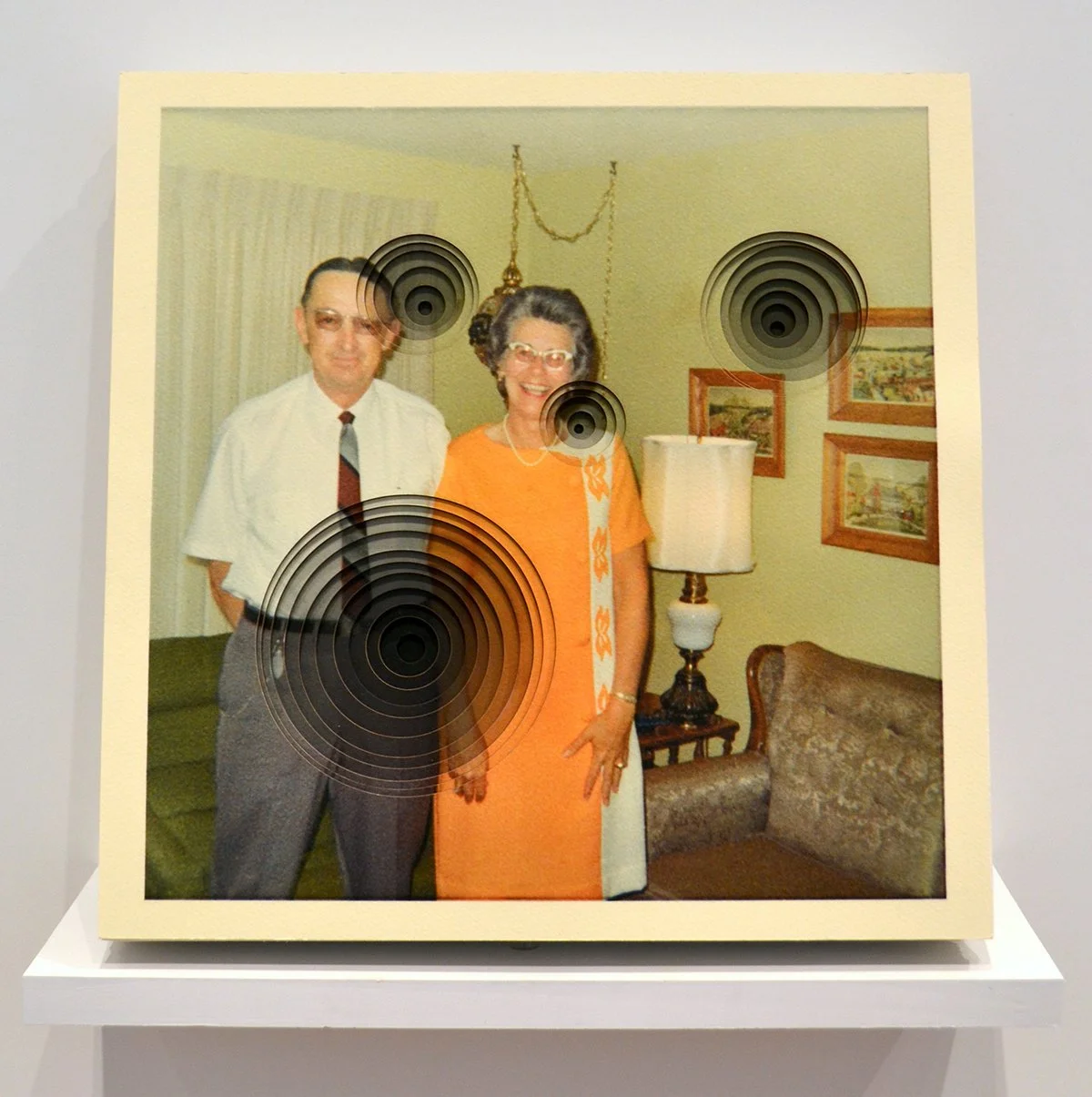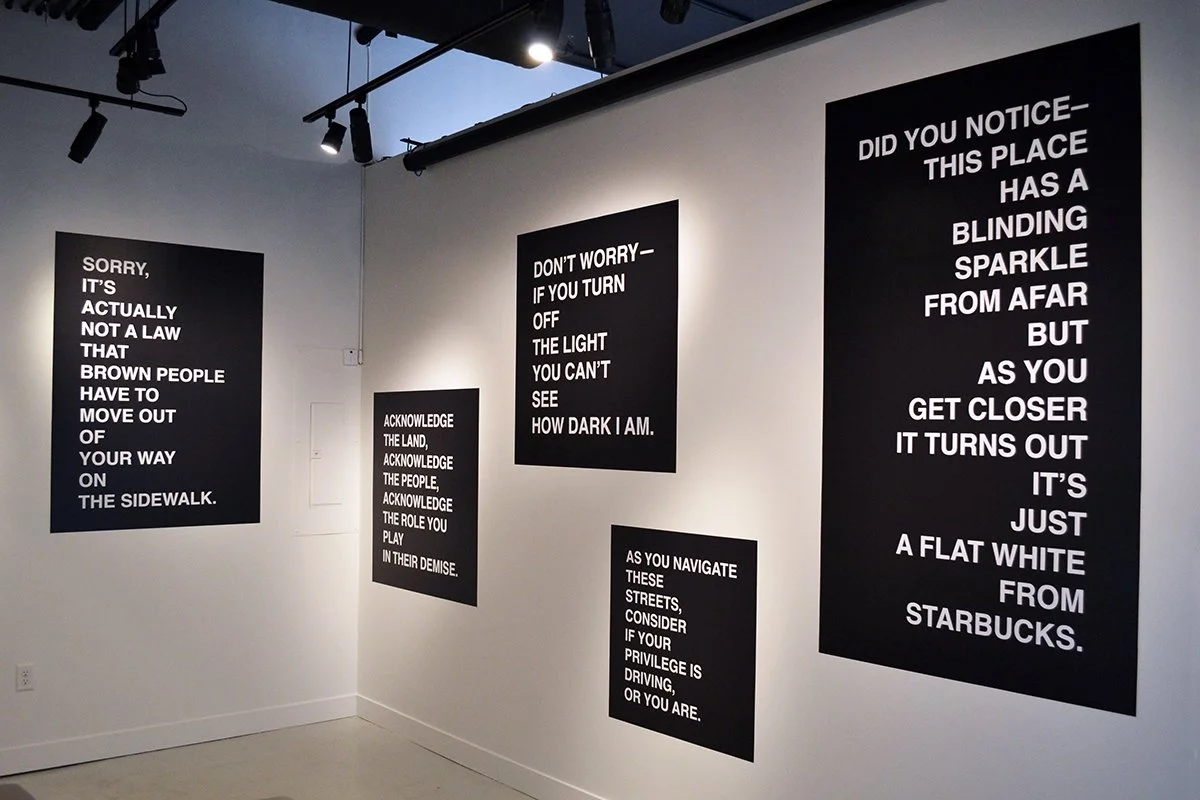]MARGINS[
Migiwa Orimo: ]MARGINS[
Mariani Gallery
University of Northern Colorado, Guggenheim Hall, Room 100
1781-1799 8th Avenue, Greeley, CO 80631
January 16–February 16, 2024
Admission: Free
Review by Paloma Jimenez
Migiwa Orimo’s quietly radical exhibition at Mariani Gallery, ]MARGINS[, maps out space for the overlooked aspects of life, revealing the poignant significance of untold narratives. She pieces together society’s marginalia to dismantle commonly perceived hierarchies of value. Orimo’s materials include fabric, thread, and paper, but she also uses the spaces between spoken words, fragments of ephemera, and forgotten histories to communicate unspeakable emotions.
A view of Migiwa Orimo’s exhibition ]Margins[ at Mariani Gallery at The University of Northern Colorado. Image by Paloma Jimenez.
Words and letters—stitched, typed, written—populate the works in the exhibition. Born in Tokyo and currently based in Ohio, Orimo describes her relationship to language as follows: “As an immigrant navigating my daily life using two vastly different languages, I consistently operate within an in-between space. This gap space is also a vantage point from which I view and probe what surrounds us.” [1]
A view of Migiwa Orimo’s exhibition ]Margins[. Image by Paloma Jimenez.
The “gap space” in Orimo’s work lends a provisional quality to the pieces. Embroidery floss is left hanging, and torn bits of paper jut out at errant angles. The unfussy methods of attachment, such as black safety pins, indicate Orimo’s malleable process. Her black fabric panel works look like enlarged pages out of a field biologist’s notebook; layers of ephemera, such as newspaper clippings, handwritten notes, photographs, and feathers, compose the cryptic message behind the mixed media piece Notes 4:5.
Migiwa Orimo, Notes 4:5, 2022, mixed media. Image by Paloma Jimenez.
The last lengths of a green and white string meander across the piece, knotted with attempts to delineate a clear path. A small clipping of text is partially visible through a screen of yellow organza. It details the United States’ suppression of images and videos taken in the aftermath of the atomic bombing of Hiroshima and Nagasaki. The historical records that survive rely on what we choose to remember and what ends up discarded. Oftentimes, the truth gets thrown out. As Notes 4:5 reveals, we need to take a closer look at marginalized perspectives and histories.
A detail view of feathers, notes, texts, and the yellow organza in Migiwa Orimo’s Notes 4:5, 2022, mixed media. Image by Paloma Jimenez.
Migiwa Orimo, Marginalia: White Noise, 2023, fabric, embroidery floss, and vintage postcards. Image by Paloma Jimenez
Orimo grapples with concealed messages in other works. Marginalia: White Noise visually murmurs with dots of gray and white knots. The phrase “white noise” is embroidered, in Japanese on the left and in English on the right, into the structured black fabric. Each half of the panel contains similar elements, but they are not mirror images. Square cutouts from postcards document glimpses of scenic natural scenery and float around and inside three-dimensional organza rectangles—moments of stillness amidst surrounding noise.
A detail view of one of the two panels in Migiwa Orimo’s Marginalia: White Noise, 2023, fabric, embroidery floss, and vintage postcards. Image by Paloma Jimenez
Migiwa Orimo, Marginalia: Surrogate Writing, 2023, fabrics and embroidery floss. Image by Paloma Jimenez.
When language falters or feels inadequate, silence becomes a familiar companion. Orimo’s compositions uncover the endless information that exists in that silence. In Marginalia: Surrogate Writing, emptiness heightens tactile presence. Dashed rows of wobbly embroidery echo lines of text on a page, but the artist has almost entirely removed words from the panel—only their larger structural constraints remain. Two phrases remain: “excavated words” and “surrogate writing.” Lest we forget the fallibility of language, red editing marks stand out. The rectangles affixed to the border of the piece become folder tabs; the piece is only one part of an ongoing file of research.
A detail view of the embroidery in Migiwa Orimo’s Marginalia: Surrogate Writing, 2023, fabrics and embroidery floss. Image by Paloma Jimenez.
Migiwa Orimo, The Day Before Tomorrow: Sites and Footprints of ICE Detention Centers, 2019, Sumi ink on pages of a Dictionary of the Underworld, wooden boxes, and painted artificial birds. Image by Paloma Jimenez.
The Day Before Tomorrow: Sites and Footprints of ICE Detention Centers span an entire wall. On pages taken from the Dictionary of the Underworld, a social history book by Eric Partridge that documents the language surrounding the criminal world, Orimo uses Sumi ink to block out the shapes of ICE detention centers. Corresponding with a dictionary entry on the bottom of each page, she represents the buildings from an aerial perspective. The shapes read like ominous sigils for the unjust mass incarceration of non-citizens. Nearby, artificial yellow birds are attached to small wooden structures, immobilized but waiting for freedom.
A detail view of an ink drawing in Migiwa Orimo’s The Day Before Tomorrow: Sites and Footprints of ICE Detention Centers, 2019, Sumi ink on pages of a Dictionary of the Underworld, wooden boxes, and painted artificial birds. Image by Paloma Jimenez.
A view of the boxes and yellow birds in Migiwa Orimo’s The Day Before Tomorrow: Sites and Footprints of ICE Detention Centers, 2019, Sumi ink on pages of a Dictionary of the Underworld, wooden boxes, and painted artificial birds. Image by Paloma Jimenez.
Orimo explains her interest in sites of imprisonment: “My aim is to reimagine and reshape the areas that are often excluded, suppressed, or overlooked by dominant narratives or structures . . . I aim to represent these spaces as sites of complexity, diversity, resistance, and resilience.” [2]
Migiwa Orimo, Field Margins, 2023, mixed media. Image by Paloma Jimenez.
Field Margins, a mixed media floor installation, further harvests meaning from overlooked areas. Words referencing waste sites, invasive plants, and disruptive infrastructure rest upon the beige pieces of fabric. Normally placed in empty landscapes with few resources other than plentiful wind gusts, small windmills preside over the dusty tones of the installation.
A detail view of Migiwa Orimo’s of Field Margins, 2023, mixed media. Image by Paloma Jimenez.
Rocks, the foundation of so many built structures, huddle together in piles, line up, and form circles on the ground. A closer inspection reveals that Orimo constructed the rocks by tenderly stitching together irregular cuts of fabric in gray tones. Buttons hold together the various fabric panels of the installation, indicating interchangeable orientation. Postcards depicting nondescript landscapes and barbed wire fences boast, “WISH YOU WERE HERE. . .” Life in a non-stereotypically beautiful place still has value.
A view of Migiwa Orimo’s exhibition ]Margins[. Image by Paloma Jimenez.
Migiwa Orimo’s work is a thought-provoking blend of focused historical research and poetic expression. ]Margins[ releases art from the constraints of dominant visual and social hierarchies, urging us to see, think, and feel deeper than the attention economy would prefer. Orimo is actively constructing an archive for spaces that slip through visibility, held together with the materials of life.
Paloma Jimenez (she/her) is an artist, writer, and teacher. Her work has been exhibited throughout the United States and has been featured in international publications. She received her BA from Vassar College and her MFA from Parsons School of Design.
[1] From Migiwa Orimo’s artist statement for ]MARGINS[ at Mariani Gallery.
[2] Ibid.


![]MARGINS[](https://images.squarespace-cdn.com/content/v1/5dade78ef3de04278ab5b4e8/1706556791874-RM7RABP1MHJ4GM9S100G/orimo_notes45+%281%29.jpg)


















